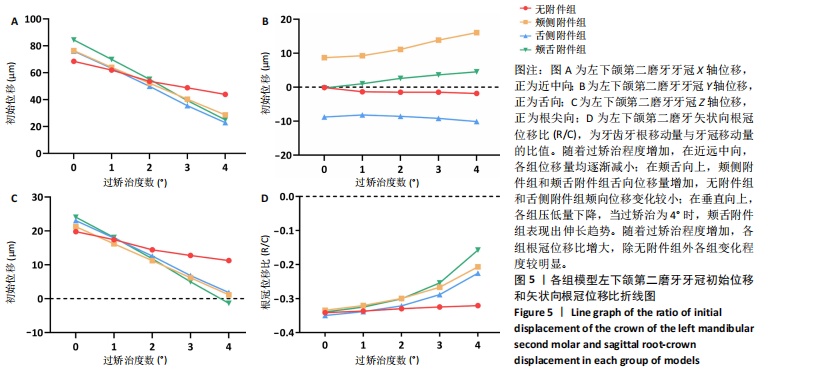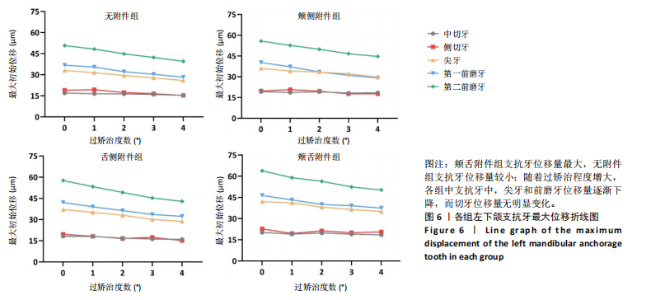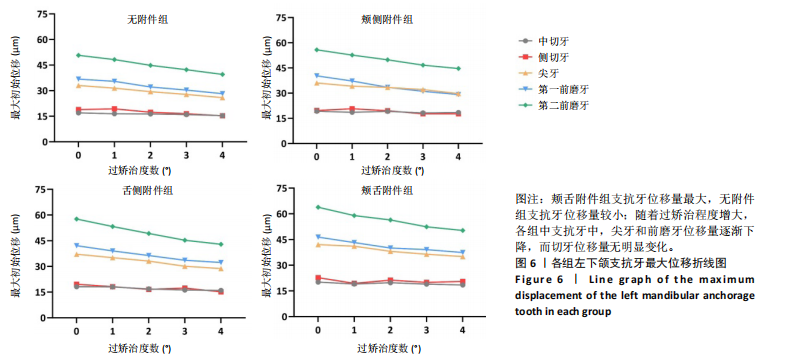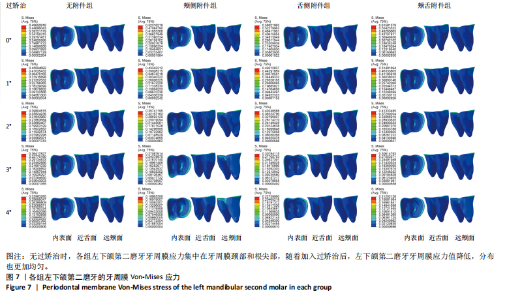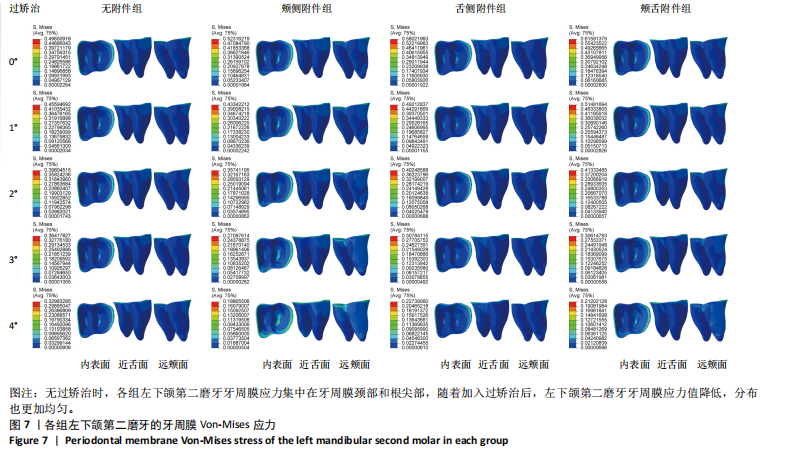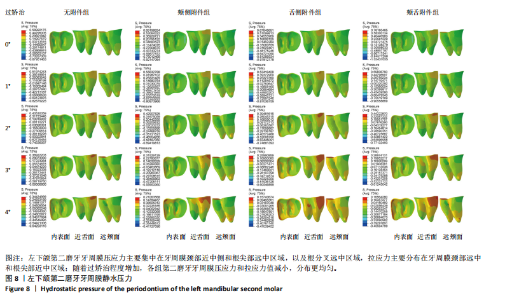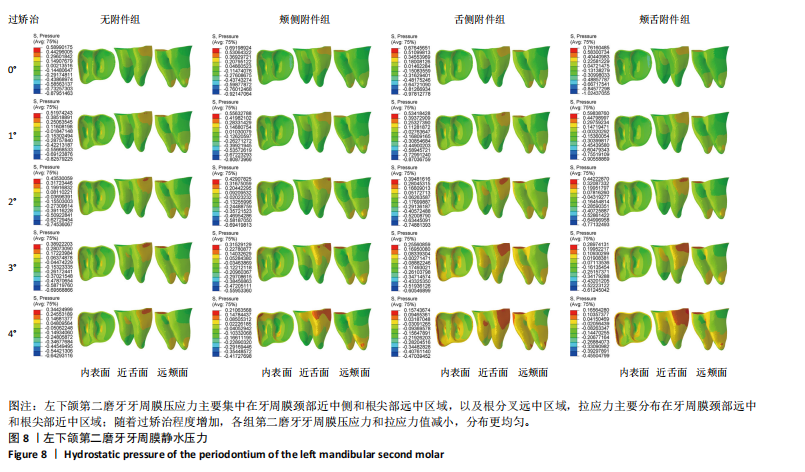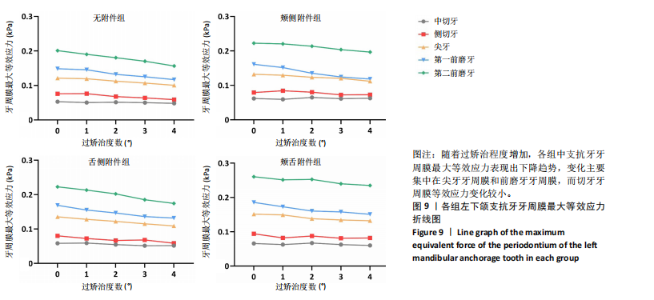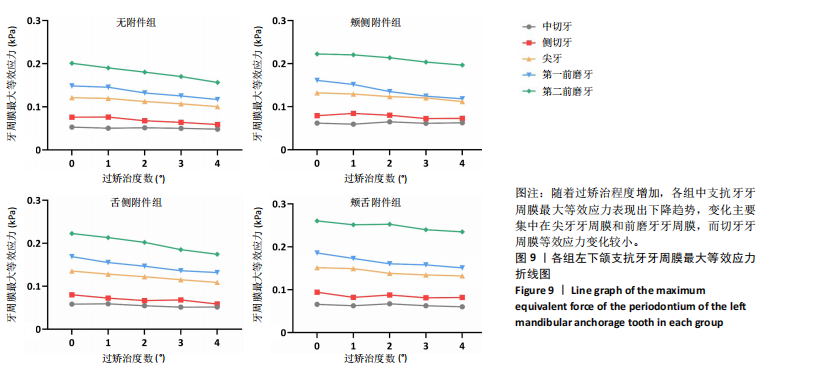Chinese Journal of Tissue Engineering Research ›› 2026, Vol. 30 ›› Issue (4): 832-840.doi: 10.12307/2026.505
Previous Articles Next Articles
Three-dimensional finite element analysis of mandibular second molar mesial movement by clear aligner
Qiu Shenglei1, 2, Li Daokun1, 2, Wang Chunjuan3, Li Na2
- 1School of Stomatology, North Sichuan Medical College, Nanchong 637000, Sichuan Province, China; 2Silk Road Stomatology Clinic, Affiliated Hospital of North Sichuan Medical College, Nanchong 637000, Sichuan Province, China; 3Chongqing Key Laboratory of Oral Disease and Biomedicine, Chongqing Key Laboratory of Municipal Dental Biomedical Engineering of Chongqing Colleges and Universities, Chongqing 401147, China
-
Received:2024-11-22Accepted:2025-01-14Online:2026-02-08Published:2025-05-15 -
Contact:Li Na, Master, Associate chief physician, Silk Road Stomatology Clinic, Affiliated Hospital of North Sichuan Medical College, Nanchong 637000, Sichuan Province, China -
About author:Qiu Shenglei, Master candidate, School of Stomatology, North Sichuan Medical College, Nanchong 637000, Sichuan Province, China; Silk Road Stomatology Clinic, Affiliated Hospital of North Sichuan Medical College, Nanchong 637000, Sichuan Province, China -
Supported by:the Research Fund Project of North Sichuan Medical College, No. 2023LC002 (to LN)
CLC Number:
Cite this article
Qiu Shenglei, Li Daokun, Wang Chunjuan, Li Na. Three-dimensional finite element analysis of mandibular second molar mesial movement by clear aligner[J]. Chinese Journal of Tissue Engineering Research, 2026, 30(4): 832-840.
share this article
Add to citation manager EndNote|Reference Manager|ProCite|BibTeX|RefWorks
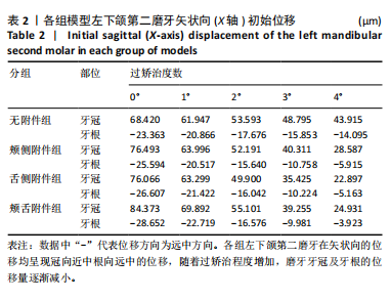
2.1 牙齿位移趋势 2.1.1 牙列整体位移趋势 在所有分组中,牙齿移动主要集中在左下颌区,左下颌第二磨牙与支抗牙表现为倾斜移动趋势,见图4。在无过矫治时,所有分组中左下颌第二磨牙均表现出近中倾斜移动趋势,牙冠向近中移动,牙根向远中移动。尖牙和前磨牙为牙冠向远中,牙根向近中的倾斜移动趋势,切牙为冠舌向倾斜移动趋势。在添加4°的过矫治以后,所有分组中的牙齿仍保持相似移动趋势,第二磨牙呈近中倾斜移动趋势,尖牙和前磨牙呈远中倾斜移动趋势,切牙向舌侧倾斜移动。 2.1.2 左下颌第二磨牙位移趋势 在矢状向上观察,当未应用过矫治时,所有分组中牙齿移动趋势相似,左下颌第二磨牙均表现出牙冠向近中、牙根向远中的近中倾斜移动趋势。位移量见表2,图5A所示,无附件组初始位移量最小,颊舌附件组最大,颊侧附件组与舌侧附件组相近。随着过矫治程度增大,所有分组中第二磨牙初始位移量都表现出减小,仍然呈近中倾斜移动趋势,颊舌附件组位移变化程度最大,舌侧附件组、颊侧附件组次之,无附件组变化程度最小。"
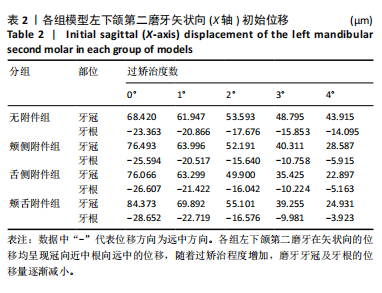
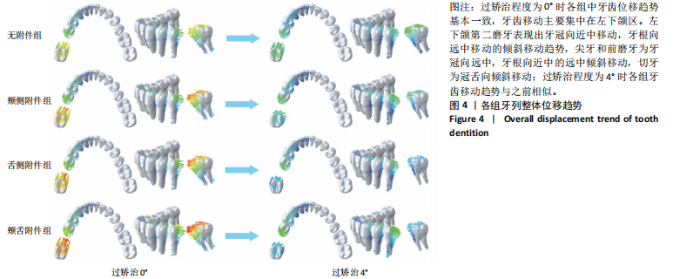
从颊舌向观察,左下颌第二磨牙位移见图5B所示,在未应用过矫治时,无附件组与颊舌附件组第二磨牙未表现出明显的倾斜趋势,舌侧附件组第二磨牙表现出牙冠向颊侧倾斜,颊侧附件组为牙冠向舌侧倾斜。在应用过矫治后,无附件组第二磨牙出现颊侧倾斜趋势,颊舌附件组第二磨牙出现舌侧倾斜趋势。随着过矫治程度增大,颊侧附件组与颊舌附件组位移量增加,而无附件组与舌侧附件组位移变化相对较小。 在垂直向上,未应用过矫治的情况下,所有分组中左下颌第二磨牙均表现为压低趋势,见图5C。压低量从小到大依次为无附件组<颊侧附件组<舌侧附件组<颊舌附件组。随着过矫治程度增加,各组中第二磨牙压低量均下降,颊舌附件组磨牙压低量下降程度相对最大,然后是舌侧附件组、颊侧附件组,无附件组磨牙压低量下降程度相对最小。当过矫治达到4°时,无附件组、颊侧附件组和舌侧附件组第二磨牙仍然表现出压低趋势,而颊舌附件组由压低变为伸长。 使用根冠位移比R/C评估磨牙位移倾斜程度[26],此次研究中,磨牙在矢状向上牙冠与牙根的位移方向均相反,R/C为负值,因此R/C比值越大,越接近0,表示牙冠与牙根相对运动越小,牙倾斜趋势越小。当无过矫治时,各组R/C比值相近,而随过矫治程度增大,各组R/C比值均表现出增大,舌侧附件组、颊侧附件组与颊舌附件组的R/C比值明显增加,颊舌附件组变化程度最大,当过矫治大于3°时,颊舌附件组倾斜程度最小,见图5D。 2.1.3 支抗牙位移趋势 在左下颌第二磨牙近中移动过程中,尖牙和前磨牙呈远中倾斜移动趋势,切牙呈舌侧倾斜移动趋势。支抗牙最大位移量见图6,当未应用过矫治时,颊舌附件组中支抗牙的位移量最大,其次是舌侧附件组、颊侧附件组,无附件组最小。与无附件组相比,支抗牙的位移量差异在尖牙和前磨牙中最明显。随着第二磨牙过矫治程度增大,在所有分组中都观察到了尖牙和前磨牙位移量的减小,而下切牙的位移量无明显的变化,在颊舌附件组中支抗牙位移量仍然相对最大。 2.2 牙周膜应力分布 2.2.1 左下颌第二磨牙牙周膜应力 见图7。观察各组中发现,未应用过矫治的情况下,各组牙周膜Von-Mises应力主要集中在牙周膜颈部和根尖部,附件的使用使第二磨牙牙周膜最大等效应力升高,从大到小依次为颊舌附件组>舌侧附件组>颊侧附件组>无附件组。加入过矫治后,各组中最大等效应力值明显减小,应力分布也更加均匀。在第二磨牙近中移动过程中,各组牙周膜内静水压力分布与牙齿位移趋势一致,见图8。压应力主要集中在牙周膜近中侧颈部和根尖部远中区域,在根分叉区域远中也可以观察到压应力的集中;拉应力主要集中在牙周膜颈部远中和根尖部近中区域。随着过矫治程度逐渐增大,各组第二磨牙位移幅度减小同时牙周膜中压、拉应力值也在减小,分布也更加均匀。"
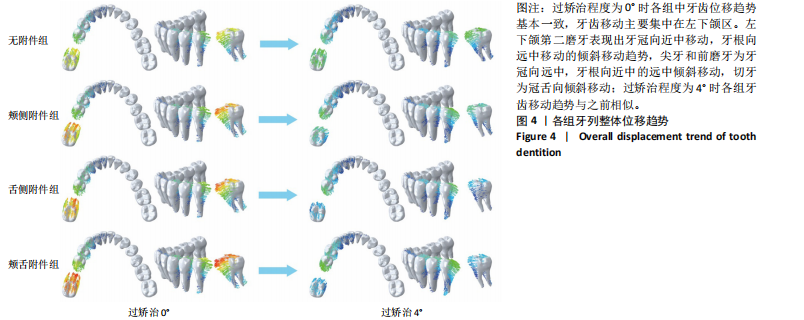
| [1] LAKHANI S, NOBLE F, RODD H, et al. Management of children with poor prognosis first permanent molars: an interdisciplinary approach is the key. Br Dent J. 2023;234(10):731-736. [2] WANG MQ, XUE F, HE JJ, et al. Missing posterior teeth and risk of temporomandibular disorders. J Dent Res. 2009;88(10):942-945. [3] HONG H, ZHOU J, FAN Q, et al. Characteristics of spatial changes in molars and alveolar bone resorption among patients with loss of mandibular first molars: A cbct-based morphometric study. J Clin Med. 2023;12(5):1932. [4] BAIK UB, JUNG JY, JUNG HJ, et al. Alveolar bone changes after molar protraction in young adults with missing mandibular second premolars or first molars. Angle Orthod. 2022;92(1):64-72. [5] 李思进, 李永明. 第二磨牙近中移动关闭第一磨牙缺失或拔除间隙的临床应用[J]. 中国实用口腔科杂志,2024,17(5):591-596. [6] AMAN M, JEELANI W, AHMED M, et al. Alveolar bone loss and root resorption in mesialized second molars in mandibular first molar extraction cases as compared to contralateral non-extraction side in young adults: A retrospective cross-sectional study. Int Orthod. 2023;21(3):100774. [7] 李春霞, 周思颖, 米丛波. 正畸前移第二磨牙关闭第一磨牙间隙的临床疗效分析[J].中国美容医学,2023,32(12):132-135. [8] JIANG Q, LI J, MEI L, et al. Periodontal health during orthodontic treatment with clear aligners and fixed appliances: A meta-analysis. J Am Dent Assoc. 2018;149(8):712-720.e12. [9] FANG X, QI R, LIU C. Root resorption in orthodontic treatment with clear aligners: A systematic review and meta-analysis. Orthod Craniofac Res. 2019;22(4):259-269. [10] CASTROFLORIO T, SEDRAN A, PARRINI S, et al. Predictability of orthodontic tooth movement with aligners: effect of treatment design. Prog Orthod. 2023;24(1):2. [11] YASSIR YA, NABBAT SA, MCINTYRE GT, et al. Clinical effectiveness of clear aligner treatment compared to fixed appliance treatment: an overview of systematic reviews. Clin Oral Investig. 2022;26(3):2353-2370. [12] PALONE M, PIGNOTTI A, MORIN E, et al. Analysis of overcorrection to be included for planning clear aligner therapy: a retrospective study. Angle Orthod. 2023;93(1):11-18. [13] HONG YY, ZHOU MQ, CAI CY, et al. Efficacy of upper-incisor torque control with clear aligners: a retrospective study using cone-beam computed tomography. Clin Oral Investig. 2023;27(7):3863-3873. [14] 黄钖钖, 刘浩, 王诗语,等. 过矫治设计在无托槽隐形矫治中的应用现状[J].口腔医学,2023,43(9):849-853. [15] NUCERA R, DOLCI C, BELLOCCHIO AM, et al. Effects of composite attachments on orthodontic clear aligners therapy: A systematic review. Materials (Basel). 2022;15(2):533. [16] 周妍, 彭友俭. 双矩形附件对透明矫治器磨牙近中移动的三维有限元分析[J]. 口腔医学,2023,43(10):883-888. [17] 李晨, 朱广智, 康小翠,等. 下颌第一磨牙近中移动的三维有限元分析[J]. 口腔医学研究,2023,39(7):634-639. [18] WANG S, HUANG Y, FAN D, et al. Effects of overtreatment with different attachment positions on maxillary anchorage enhancement with clear aligners: a finite element analysis study. BMC Oral Health. 2023;23(1):693. [19] BARONE S, PAOLI A, RAZIONALE AV, et al. Computational design and engineering of polymeric orthodontic aligners. Int J Numer Method Biomed Eng. 2017;33(8):e2839. [20] WANG CY, SU MZ, CHANG HH, et al. Tension-compression viscoelastic behaviors of the periodontal ligament. J Formos Med Assoc. 2012; 111(9):471-481. [21] GAO J, GUO D, ZHANG X, et al. Biomechanical effects of different staging and attachment designs in maxillary molar distalization with clear aligner: a finite element study. Prog Orthod. 2023;24(1):43. [22] YE N, BROWN BE, MANTELL SC, et al. Validation of finite element models for orthodontic aligners. J Mech Behav Biomed Mater. 2022; 134:105404. [23] ELSHAZLY TM, BOURAUEL C, ALDESOKI M, et al. Computer-aided finite element model for biomechanical analysis of orthodontic aligners. Clin Oral Investig. 2023;27(1):115-124. [24] LI N, WANG C, YANG M, et al. Effects of different tooth movement patterns and aligner thicknesses on maxillary arch expansion with clear aligners: a three-dimensional finite element study. Front Bioeng Biotechnol. 2024;12:1424319. [25] GOMEZ JP, PEÑA FM, MARTÍNEZ V, et al. Initial force systems during bodily tooth movement with plastic aligners and composite attachments: A three-dimensional finite element analysis. Angle Orthod. 2015;85(3):454-460. [26] LYU X, CAO X, YAN J, et al. Biomechanical effects of clear aligners with different thicknesses and gingival-margin morphology for appliance design optimization. Am J Orthod Dentofacial Orthop. 2023;164(2): 239-252. [27] KORU AKAN BE, HANCIOĞLU KIRCELLI B, PAŞAOĞLU BOZKURT A, et al. A finite element analysis of the effects of semipontic design on tooth movement during mesialization of the mandibular second molar with clear aligners. Am J Orthod Dentofacial Orthop. 2024;166(5):490-502. [28] LYU X, CAO X, CHEN L, et al. Accumulated biomechanical effects of mandibular molar mesialization using clear aligners with auxiliary devices: an iterative finite element analysis. Prog Orthod. 2023;24(1):13. [29] ALDAYEL AM, ALGAHNEM ZJ, ALRASHIDI IS, et al. Orthodontics and temporomandibular disorders: an overview. Cureus. 2023;15(10): e47049. [30] MELSEN B, MCNAMARA JA JR, HOENIE DC. The effect of bite-blocks with and without repelling magnets studied histomorphometrically in the rhesus monkey (macaca mulatta). Am J Orthod Dentofacial Orthop. 1995;108(5):500-509. [31] BOYD RL. Esthetic orthodontic treatment using the invisalign appliance for moderate to complex malocclusions. J Dent Educ. 2008;72(8):948-967. [32] 施则安, 夏恺, 罗良语,等. 无托槽隐形矫治器联合微种植体内收并压低上前牙的三维有限元分析[J].华西口腔医学杂志,2022, 40(5):589-596. [33] CICCIÙ M. Bioengineering methods of analysis and medical devices: A current trends and state of the art. Materials (Basel). 2020;13(3):797. [34] SINGH JR, KAMBALYAL P, JAIN M, et al. Revolution in orthodontics: finite element analysis. J Int Soc Prev Community Dent. 2016;6(2):110-114. |
| [1] | Zheng Xuying, Hu Hongcheng, Xu Libing, Han Jianmin, Di Ping. Stress magnitude and distribution in two-piece cement-retained zirconia implants under different loading conditions and with varying internal connection shapes [J]. Chinese Journal of Tissue Engineering Research, 2026, 30(8): 1979-1987. |
| [2] | Zhong Caihong, Xiao Xiaoge, Li Ming, Lin Jianhong, Hong Jing. Biomechanical mechanism of sports-related patellar tendinitis [J]. Chinese Journal of Tissue Engineering Research, 2026, 30(6): 1417-1423. |
| [3] | Xu Hao, Ding Lu, Li Xiao. Mechanical effect of mechanical wear of abutment screws on the Morse taper connection implant system: a three-dimensional finite element analysis [J]. Chinese Journal of Tissue Engineering Research, 2026, 30(6): 1375-1383. |
| [4] | Shang Depeng, Wei Haiyu, Yang Fan. Finite element analysis for three different types of internal screw fixation in treatment of severe lumbar 1 vertebral body fractures [J]. Chinese Journal of Tissue Engineering Research, 2026, 30(3): 537-545. |
| [5] | Yu Xinlin, Chen Huiyu, Wang Yingying, Guo Weizhong, Feng Bin Lin Chengshou, Lin Wang. Finite element analysis of internal fixation with new retrograde intramedullary nail on lateral femur condyle for distal type A2 femur fractures [J]. Chinese Journal of Tissue Engineering Research, 2026, 30(3): 546-552. |
| [6] | Zhao Jingang, Liu Liping, Chen Jianwei, . Finite element analysis comparing lumbar fusion and artificial intervertebral disc replacement [J]. Chinese Journal of Tissue Engineering Research, 2026, 30(3): 553-560. |
| [7] | Wang Meng, Lu Tan, Li Minjie, Liu Zhicheng, Guo Xiaoyong. Finite element analysis of stress distribution of anchors at different implantation depths under different bone density conditions in rotator cuff tears [J]. Chinese Journal of Tissue Engineering Research, 2026, 30(3): 561-569. |
| [8] | Ma Jingbo, Yang Guangnan, Liu Jiang, Jiang Qiang, Zhang Hanshuo, Han Jiaheng, Ding Yu. Endoscopic lumbar canal decompression for upper lumbar spinal stenosis: a comparison of biomechanical stability of three surgical models [J]. Chinese Journal of Tissue Engineering Research, 2026, 30(3): 577-585. |
| [9] | Abudusalamu·Tuoheti, Xiao Yang, Wang Yixi, Musitapa·Mijiti, Chen Qihao, Maimaitiming·Saiyiti, Guo Hailong, Paerhati·Rexiti. Effects of three internal fixation techniques on biomechanics of adjacent segment degeneration in lumbar interbody fusion [J]. Chinese Journal of Tissue Engineering Research, 2026, 30(3): 586-595. |
| [10] | Cheng Yanan, Yu Jiazhi, Liu Yinchang, Wu Jie, Yu Tong, Wang Lu, Li Xiaoguang. Three-dimensional finite element analysis of molar distalization with clear aligners with different thicknesses and edges [J]. Chinese Journal of Tissue Engineering Research, 2026, 30(2): 310-318. |
| [11] | Kang Zirui, Wu Yang, Song Hailong, Yang Qiaoyun, Zang Lixiang, Xu Dongliang. Finite element analysis of implants with different crown-to-implant ratios under different bone conditions [J]. Chinese Journal of Tissue Engineering Research, 2026, 30(2): 319-328. |
| [12] | Xu Hao, Ding Lu, Li Xiao. Investigating the effect of the mechanical wear on abutment screw in Morse taper connection implant implant system by using finite element analysis [J]. Chinese Journal of Tissue Engineering Research, 2025, 29(在线): 1-9. |
| [13] | Sun Xiaojun, Wang Huaming, Zhang Dehong, Song Xuewen, Huang Jin, Zhang Chen, Pei Shengtai. Effect of finite element method in treatment of developmental dysplasia of the hip in children [J]. Chinese Journal of Tissue Engineering Research, 2025, 29(9): 1897-1904. |
| [14] | Li Liangkui, Huang Yongcan, Wang Peng, Yu Binsheng. Effect of anterior controllable anteriodisplacement and fusion on vertebrae-ossification of posterior longitudinal ligament complex and implants: a finite element analysis [J]. Chinese Journal of Tissue Engineering Research, 2025, 29(9): 1761-1767. |
| [15] | Xu Biao, Lu Tan, Jiang Yaqiong, Yin Yujiao. Xu Biao, Lu Tan, Jiang Yaqiong, Yin Yujiao [J]. Chinese Journal of Tissue Engineering Research, 2025, 29(9): 1768-1774. |
| Viewed | ||||||
|
Full text |
|
|||||
|
Abstract |
|
|||||

